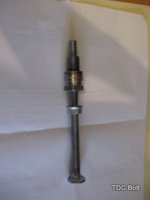Right, here's the latest: got an email back from Jerry and he said the following;
The new firing order is RH piston in TDC valves closed.
The location pin of the advance unit to the top.
270 degr .later the left piston in TDC valves closed.
If it is not like this , then I made a mistake!
In some cases people ask me to make it on a different way.
It is possible that I made this . during that week I made more cams
On a different way.
Then I have to make another cam for you.
Please check it.
I checked and it sure ain't like that. No access to a compression tester (or balloon!) this evening, but got handy with the degree wheel and separate pointers for left and right as per Mrriggs. Here's what I got...
With Left @ TDC (pointer No.1 = zero degrees)
Inlet Valve opens @ 38 BTDC; Fully open @ 105 ATDC; closes @ 120 ATDC
Exhaust Valve opens @ 105 ATDC; Fully open @ 120 BTDC; closes @ 38 ATDC
(this looks ok)
With Right @ TDC (pointer No.2 = zero degrees)
In opens @ 150 BTDC; Fully open @ 80 BTDC; closes @ 80 ATDC (!!!)
Ex opens @ 68 BTDC; Fully open @ 68 ATDC; closes @ 150 BTDC
Shining a torch through the right plug hole it looks like the inlet valve actually touches the piston at the top of its stroke - I think this is causing the 'jump' that I referred to in an earlier post. Thank **** I didn't try starting the engine in this state!
Finally I measured rotation from tdc on one side to tdc on the other:
With Left @ TDC, Right has come up to TDC 83 degrees
before;
With Right @ TDC, L = TDC 94 degrees later.
Either way I can't see the numbers adding up to 277 - you'd have to add 180 (half a revolution) to get to 277, but wouldn't that relate to one of the pistons @
BDC ????

Upshot is I reckon I've got the wrong cam.
I'm also now wondering if the crank is correct? I'm gonna get all this info back to Jerry and see what he says. If it turns out to be incorrect either way then I trust it's a mix-up at Jerry's end and hopefully easily sorted. I'll report back in due course.
Thanks for all your thoughts so far guys



